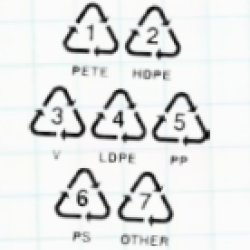Source Institutions
Source Institutions
Add to list Go to activity
Activity link broken? See if it's at the internet archive

In this activity, learners identify different plastics in a mystery bag. Learners discover that plastics are classified #1 through #7. Learners then categorize plastics based on characteristics such as density, transparency, and rigidness.
- 10 to 30 minutes
- 45 to 60 minutes
- $1 - $5 per group of students
- Ages 8 - 14
- Activity, Lesson/Lesson Plan
- English
Quick Guide
Materials List (per group of students)
- #1 plastic (clear bottle, e.g., soda, water, mouthwash, or salad dressing bottle)
- #2 plastic (opaque bottle, e.g., milk, orange juice, shampoo, or lotion bottle)
- #4 plastic (lightweight bag, e.g., bread, sandwich, and some grocery bags)
- #5 plastic (tub, e.g., yogurt, cottage cheese, or margarine container)
- #6 plastic (e.g., Styrofoam products, disposable plates and cups, plastic utensils)
- scissors
- sandwich or paper lunch bags
- plastic containers learners bring from home
- small, clear container
- water
- paper and pencils
Subjects
-
Earth and Space Science
- Earth's History
-
Life Sciences
- Ecology
-
Engineering and Technology
-
Engineering
- Environmental Engineering
- Metallurgy and Materials Engineering
-
Engineering
-
Mathematics
-
Data Analysis and Probability
- Data Analysis
- Data Collection
-
Data Analysis and Probability
-
Physical Sciences
-
Structure and Properties of Matter
- Atomic Structure
- Mass and Weight
- Volume and Density
-
Structure and Properties of Matter
-
The Nature of Science
-
Science and Society
- Risks and Benefits
- The Scientific Process
-
Science and Society
-
The Nature of Technology
-
Technology and Society
- Impacts of Technology
- Technology and the Environment
-
Technology and Society
Informal Categories
- Nature and Environment
Audience
To use this activity, learners need to:
- see
- touch
Learning styles supported:
- Involves teamwork and communication skills
- Uses STEM to solve real-world problems
- Involves hands-on or lab activities
Culture, ethnicity, and gender
-
Girls
- Explicity developed for this group
- Acknowledges this group's contributions to STEM
- Highlights STEM opportunities for this group
- Identifies role models or mentors in STEM fields from this group
- Uses inclusive images of people from this group
Other
Components that are part of this resource:
Includes alignment to state and/or national standards:
This resource is part of:
Access Rights:
- Free access
By:
Rights:
- All rights reserved, Twin Cities Public Television, Inc., 2010
Funding Sources:
- National Science Foundation, 0813519
- ExxonMobil
